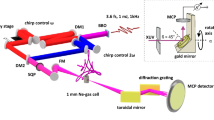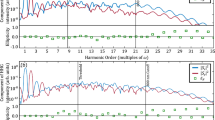Abstract
We address the role of the delayed Kerr nonlinearity associated with stimulated rotational Raman scattering on the propagation of intense ultrashort two-color filaments with elliptical polarization in gases and examine its impact on the generation of optical frequencies as well as terahertz frequencies. We find that in air the nonlinearity associated with stimulated Raman scattering strongly impacts the dynamics of the laser filaments and modifies the overall pulse spectral content. In particular, it alters the THz spectra upon propagation in the filamentation regime. Differences between linearly and circularly polarized two-color pump pulses are discussed.




Similar content being viewed by others
References
S.L. Chin, S.A. Hosseini, W. Liu, Q. Luo, F. Théberge, N. Aközbek, A. Becker, V.P. Kandidov, O.G. Kosareva, H. Schroeder, The propagation of powerful femtosecond laser pulses in optical media: Physics, applications, and new challenges. Can. J. Phys. 83, 863 (2005)
L. Bergé, S. Skupin, R. Nuter, J. Kasparian, J.P. Wolf, Optical ultrashort filaments in weakly-ionized, optically-transparent media. Rep. Prog. Phys. 70, 1633 (2007)
J. Kasparian, J.-P. Wolf, Physics and applications of atmospheric nonlinear optics and filamentation. Opt. Express 16, 466 (2008)
L. Bergé, S. Skupin, Few-cycle light bullets created by femtosecond filaments. Phys. Rev. Lett. 100, 113902 (2008)
J. Kasparian, M. Rodriguez, G. Méjean, J. Yu, E. Salmon, H. Wille, R. Bourayou, S. Frey, Y.B. André, A. Mysyrowicz, R. Sauerbrey, J.P. Wolf, L. Wöste, White-light filaments for atmospheric analysis. Science 301, 61 (2003)
T.-J. Wang, Y. Chen, C. Marceau, F. Théberge, M. Châteauneuf, J. Dubois, S.L. Chin, High energy terahertz emission from two-color laser-induced filamentation in air with pump pulse duration control. Appl. Phys. Lett. 95, 131108 (2009)
J. Liu, J. Dai, S.L. Chin, X.-C. Zhang, Broadband terahertz wave remote sensing using coherent manipulation of fluorescence from asymmetrically ionized gases. Nat. Photon. 4, 627 (2010)
L. Bergé, K. Kaltenecker, S. Engelbrecht, A. Nguyen, S. Skupin, L. Merlat, B. Fischer, B. Zhou, I. Thiele, P.U. Jepsen, Terahertz spectroscopy from air plasmas created by two-color femtosecond laser pulses: The ALTESSE project. Eur. Phys. Lett. 126, 24001 (2019)
K.Y. Kim, A.J. Taylor, J.H. Glownia, G. Rodriguez, Coherent control of terahertz supercontinuum generation in ultrafast laser-gas interactions. Nat. Photon. 2, 605 (2008)
M.D. Thomson, M. Kress, T. Löffler, H.G. Roskos, Broadband THz emission from gas plasmas induced by femtosecond optical pulses: From fundamentals to applications. Laser Photon. Rev. 1, 349 (2007)
I. Babushkin, W. Kuehn, C. Köhler, S. Skupin, L. Bergé, K. Reimann, M. Woerner, J. Herrmann, T. Elsaesser, Ultrafast spatiotemporal dynamics of terahertz generation by ionizing two-color femtosecond pulses in gases. Phys. Rev. Lett. 105, 053903 (2010)
L. Bergé, S. Skupin, C. Köhler, I. Babushkin, J. Herrmann, 3D numerical simulations of THz generation by two-color laser filaments. Phys. Rev. Lett. 110, 073901 (2013)
D.J. Cook, R.M. Hochstrasser, Intense terahertz pulses by four-wave rectification in air. Opt. Lett. 25, 1210 (2000)
A.V. Borodin, N.A. Panov, O.G. Kosareva, V.A. Andreeva, M.N. Esaulkov, V.A. Makarov, A.P. Shkurinov, S.L. Chin, X.-C. Zhang, Transformation of terahertz spectra emitted from dual-frequency femtosecond pulse interaction in gases. Opt. Lett. 38, 1906 (2013)
V.A. Andreeva, O.G. Kosareva, N.A. Panov, D.E. Shipilo, P.M. Solyankin, M.N. Esaulkov, P. González de Alaiza Martínez, A.P. Shkurinov, V.A. Makarov, L. Bergé, S.L. Chin, Ultrabroad terahertz spectrum generation from an air-based filament plasma. Phys. Rev. Lett. 116, 063902 (2016)
M. Clerici, M. Peccianti, B.E. Schmidt, L. Caspani, M. Shalaby, M. Giguère, A. Lotti, A. Couairon, F. Légaré, T. Ozaki, D. Faccio, R. Morandotti, Wavelength scaling of terahertz generation by gas ionization. Phys. Rev. Lett. 110, 253901 (2013)
A. Nguyen, K.J. Kaltenecker, J.-C. Delagnes, B. Zhou, E. Cormier, N. Fedorov, R. Bouillaud, D. Descamps, I. Thiele, S. Skupin, P.U. Jepsen, L. Bergé, Wavelength scaling of terahertz pulse energies delivered by two-color air plasmas. Opt. Lett. 44, 1844 (2019)
P. González de Alaiza Martínez, I. Babushkin, L. Bergé, S. Skupin, E. Cabrera-Granado, C. Köhler, U. Morgner, A. Husakou, J. Herrmann, Boosting terahertz generation in laser-field ionized gases using a sawtooth wave shape. Phys. Rev. Lett. 114, 183901 (2015)
V. Vaičaitis, O. Balachninaitė, U. Morgner, I. Babushkin, Terahertz radiation generation by three-color laser pulses in air filament. J. Appl. Phys. 125, 173103 (2019)
J. Dai, N. Karpowicz, X.-C. Zhang, Coherent polarization control of terahertz waves generated from two-color laser-induced gas plasma. Phys. Rev. Lett. 103, 023001 (2009)
C. Meng, W. Chen, X. Wang, Z. Lü, Y. Huang, J. Liu, D. Zhang, Z. Zhao, J. Yuan, Enhancement of terahertz radiation by using circularly polarized two-color laser fields. Appl. Phys. Lett. 109, 131105 (2016)
C. Tailliez, A. Stathopulos, S. Skupin, D. Buožius, I. Babushkin, V. Vaičaitis, L. Bergé, Terahertz pulse generation by two-color laser fields with circular polarization. New J. Phys. 22, 103038 (2020)
J.R. Peñano, P. Sprangle, P. Serafim, B. Hafizi, A. Ting, Stimulated Raman scattering of intense laser pulses in air. Phys. Rev. E 68, 056502 (2003)
R.W. Boyd (ed.), Nonlinear Optics (Academic Press, San Diego, 1992)
S. Champeaux, L. Bergé, Postionization regimes of femtosecond laser pulses self-channeling in air. Phys. Rev. E 71, 046604 (2005)
A. Nguyen, P. González de Alaiza Martínez, J. Déchard, I. Thiele, I. Babushkin, S. Skupin, L. Bergé, Spectral dynamics of THz pulses generated by two-color laser filaments in air: the role of Kerr nonlinearities and pump wavelength. Opt. Express 25, 4720 (2017)
M. Kolesik, J.V. Moloney, Nonlinear optical pulse propagation simulation: From Maxwell’s to unidirectional equations. Phys. Rev. E 70, 036604 (2004)
I. Babushkin, S. Skupin, A. Husakou, C. Köhler, E. Cabrera-Granado, L. Bergé, J. Herrmann, Tailoring terahertz radiation by controling tunnel photoionization events in gases. New J. Phys. 13, 123029 (2011)
M.V. Ammosov, N.B. Delone, V.P. Kraǐnov, Tunnel ionization of complex atoms and of atomic ions in an alternating electromagnetic field. Sov. Phys. JETP 64, 1191 (1986)
L.D. Landau, E.M. Lifshitz, Quantum Mechanics (Pergamon, New-York, 1965)
P. Sprangle, J.R. Peñano, B. Hafizi, Propagation of intense short laser pulses in the atmosphere. Phys. Rev. E 66, 046418 (2002)
T.A. Pitts, T.S. Luk, J.K. Gruetzner, T.R. Nelson, A. McPherson, S.M. Cameron, A.C. Bernstein, Propagation of self-focusing laser pulses in atmosphere: experiment versus numerical simulation. J. Opt. Soc. Am. B 21, 2008 (2004)
M. Kolesik, J.V. Moloney, M. Mlejnek, Unidirectional optical pulse propagation equation. Phys. Rev. Lett. 89, 283902 (2002)
E.R. Peck, K. Reeder, Dispersion of air. J. Opt. Soc. Am. A 62, 958 (1972)
S. Zahedpour, J.K. Wahlstrand, H.M. Milchberg, Measurement of the nonlinear refractive index of air constituents at mid-infrared wavelengths. Opt. Lett. 40, 5794 (2015)
O.D. Jefimenko, Electricity and Magnetism: An Introduction to the Theory of Electric and Magnetic Fields (Appleton-Century-Crofts, New York, 1966)
Acknowledgements
The authors acknowledge the Agence Nationale de la Recherche (ANR - ALTESSE: ANR-19-ASMA-0007). Numerical simulations were performed using resources at Grand Équipement National de Calcul Intensif (GENCI) (A0100507594). S. Skupin thanks the Qatar National Research Fund (NPRP 12S-0205-190047) for support.
Author information
Authors and Affiliations
Corresponding author
Appendix
Appendix
1.1 The microscopic Raman response
Here we derive the nonlinear polarization vector due to Raman scattering in air molecules, assumed to be only due to the rotations of non-interacting dinitrogen molecules. We shall suppose that \(N_2\) molecules have only three energy levels \(W_1\), \(W_2\) and \(W_3\). The first two levels are rotational states attainable by Stockes scattering, and the third is a virtual level of energy much higher than the other two, such that it cannot be directly excited by the laser, i.e., \(W_3 \gg W_2 - W_1\). We note \(\Omega _1\), \(\Omega _2\) and \(\Omega _3\) the respective natural frequencies of these states and \(\Omega _{nm}=\Omega _n-\Omega _m\). In view of the above hypotheses, one has \(\Omega _{21} \ll \omega _0 \ll \Omega _{32}\).
Let us define \(\psi (t,{\overrightarrow {r}})\) the molecular wave function of dinitrogen. We also note \(H_0\) the unperturbed Hamiltonian and \(V(t,{\overrightarrow { r}}) = -{\overrightarrow {\mu }}\cdot {\overrightarrow {E}} = -\mu _xE_x - \mu _yE_y = V_x + V_y\) the perturbation operator of the Hamiltonian, with \({\overrightarrow {\mu }} = -e{\overrightarrow {r}}\) the dipole moment vector of \(N_2\) molecules. The Schrödinger equation is therefore written:
The molecular wave function \(\psi\) is decomposed into the sum of eigenstates of \(H_0\), \(u_n({\overrightarrow {r}})\), where n is an integer between 1 and 3, \(\hbar \Omega _n\) the associated eigenvalues, and \(\langle u_m |u_n \rangle = \delta _{mn}\), with \(\delta _{mn}\) being the Kronecker symbol. Following [23], we substitute
into Eq. (15) and treat separately each of its contributions defining \(({\overrightarrow {\mu} } \cdot {\overrightarrow {E}})_{mn} \equiv \mu _{mn}^x E_x + \mu _{mn}^y E_y\) with \(\mu _{mn}^{x,y} = \langle u_m |\mu _{x,y} |u_n\rangle\). The time dependent coefficients \(c_n\) must then satisfy
The microscopic polarization vector \({\overrightarrow {p}}\) is defined as
with \(\rho _{mn} = c_m c_n^*\). By noticing that \(\rho _{nm}^* = \rho _{mn}\), \(\mu _{mn}^{x,y} = (\mu _{nm}^{x,y})^*\) and \(({\overrightarrow {\mu }} \cdot {\overrightarrow {E}})_{mn} = ({\overrightarrow {\mu }} \cdot {\overrightarrow {E}})_{nm}^*\), one gets
Similar assumptions as in [23], among which \(\rho _{33} = \mu ^{x,y}_{12} = \mu ^{x,y}_{ii} = 0\) (\(1 \le i \le 3\)), imply that the non-zero \(\mu ^x_{mn}\) (resp. \(\mu ^y_{mn}\)) are all equal and assimilate all the related coefficients \(({\overrightarrow {\mu }} \cdot {\overrightarrow {E}})_{mn}\) to \(({\overrightarrow {\mu }} \cdot {\overrightarrow {E}})\).
Let us now calculate the elements participating in the macroscopic dipole moment. Using the relation Eq. (18), we obtain
where \(\rho _{13}\) and \(\rho _{32}\) are governed by Eq. (19).
To integrate the two equations for \(\rho _{13}\) and \(\rho _{32}\), we neglect the time variations of \(\rho _{11}\), \(\rho _{12}\), \(\rho _{21}\) and \(\rho _{22}\) compared to those of \(\rho _{13}\) and \(\rho _{32}\), because \(\Omega _{31} \gg \Omega _{21}\) and \(\Omega _{31} \sim \Omega _{32}\). With initially \(\rho _{13}(t=0) = \rho _{32}(t=0) = 0\), this integration results in
Since \(\rho _{11} + \rho _{22} \simeq 1\) and state 2 remains sparsely populated compared to state 1, we can also assume \(\rho _{11} - \rho _{22} \simeq 1\). \(\rho _{12}\) is thus given by Eq. (19) as
Following [23], we add an heuristic population decrease of \(\rho _{12}\), related to a decay term with lifetime \(\tau _2\). Introducing \(\tau _1 = \Omega _{21}^{-1}\), we get
Using these expressions, we can simplify the nonlinear part of the polarization vector oriented along \({\hat{\mu }}={\overrightarrow {\mu }}/\mu\) to
and finally obtain after solving Eq. (24)
Finally let \(\xi\) be the angle between \({\overrightarrow {\mu }}\) and \({\overrightarrow { e}}_x\). To obtain a macroscopic expression of the Raman polarization, it is necessary to average the above relation over all angles \(\xi\) and multiply the expression by the molecular density of the medium \(N_a\). For isotropic air, the angle \(\xi\) is distributed uniformly between 0 and \(2\pi\). The macroscopic Raman polarization is thus given by
After integration, we obtain the final form of the Raman polarization Eq. (5) for a vector laser field. Note that if we set \(E_y = 0\), we recover the standard one-dimensional expression of [23] for a linearly polarized laser pulse.
Rights and permissions
Springer Nature or its licensor (e.g. a society or other partner) holds exclusive rights to this article under a publishing agreement with the author(s) or other rightsholder(s); author self-archiving of the accepted manuscript version of this article is solely governed by the terms of such publishing agreement and applicable law.
About this article
Cite this article
Stathopulos, A., Skupin, S. & Bergé, L. A Raman-delayed nonlinearity for elliptically polarized ultrashort optical pulses. Eur. Phys. J. Spec. Top. 232, 2285–2292 (2023). https://doi.org/10.1140/epjs/s11734-022-00671-x
Received:
Accepted:
Published:
Issue Date:
DOI: https://doi.org/10.1140/epjs/s11734-022-00671-x




